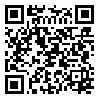Volume 79, Issue 12 (March 2022)
Tehran Univ Med J 2022, 79(12): 966-973 |
Back to browse issues page
Download citation:
BibTeX | RIS | EndNote | Medlars | ProCite | Reference Manager | RefWorks
Send citation to:



BibTeX | RIS | EndNote | Medlars | ProCite | Reference Manager | RefWorks
Send citation to:
Ghasemi Basir H R, Keramat F, Moradi A, Ghasemi Y, Saadatmand A. Comparison of antibiogram test results of patients suspected of
urinary tract infection with two methods, fast and classic. Tehran Univ Med J 2022; 79 (12) :966-973
URL: http://tumj.tums.ac.ir/article-1-11584-en.html
URL: http://tumj.tums.ac.ir/article-1-11584-en.html
1- Department of Pathology, School of Medicine, Hamadan University of Medical Sciences, Hamadan, Iran.
2- Brucellosis Research Center, Hamadan University of Medical Sciences, Hamadan, Iran.
3- Department of Community Medicine, School of Medicine, Hamadan University of Medical Sciences, Hamadan, Iran.
4- General Practitioner, School of Medicine, Hamadan University of Medical Sciences, Hamadan, Iran.
2- Brucellosis Research Center, Hamadan University of Medical Sciences, Hamadan, Iran.
3- Department of Community Medicine, School of Medicine, Hamadan University of Medical Sciences, Hamadan, Iran.
4- General Practitioner, School of Medicine, Hamadan University of Medical Sciences, Hamadan, Iran.
Abstract: (1028 Views)
Background: Urinary tract infections are among the most common diseases in different communities and occur in all age groups. Failure to diagnose the disease correctly and promptly can cause complications such as damage to the urinary tract and kidney parenchyma, increased blood pressure, uremia. Also, in pregnant female patients It may lead to premature birth and even abortion. Therefore, correct and timely administration of antibiotics is very important in the treatment of patients. This study aimed to compare the results of antibiogram testing of patients with suspected urinary tract infections by both rapid and classical methods.
Methods: This cross-sectional study was performed from the beginning of March to the beginning of September 2019, on patients with urinary tract infection Who had been referred to Sina Hospital of Hamedan, Iran. Urine samples were collected 20 cc from patients. The test was performed directly at the same time with urine culture to determine antibiotic susceptibility. The agreement between the two methods was considered as a huge error, major error and minor error. Finally, the data were statistically analyzed with SPSS software version 16.
Methods: This cross-sectional study was performed from the beginning of March to the beginning of September 2019, on patients with urinary tract infection Who had been referred to Sina Hospital of Hamedan, Iran. Urine samples were collected 20 cc from patients. The test was performed directly at the same time with urine culture to determine antibiotic susceptibility. The agreement between the two methods was considered as a huge error, major error and minor error. Finally, the data were statistically analyzed with SPSS software version 16.
|
Results: 92 patients, 23 men (25%) and 69 women (75%) with a mean age of 53.18±18.49 years were included in the study. Direct testing had a significant agreement with the standard test in 90.8% of the results (P<0.001). 9.2% of the antibiogram tests did not match, of which 0.3% were huge errors, 4.7% were major errors and 4.2% were minor errors. The highest number of microorganisms found were Escherichia coli (n=66), Klebsiella pneumoniae (n=13), Pseudomonas aeruginosa (n=6), Acinetobacter (n=1), Enterococcus (n=2), Alcaligenes (n=1), Streptococcus (n=1), Staphylococcus haemolyticus (n=1) and Moraxella (n=1) respectively. The highest rates of urinary tract infections were with Escherichia coli, third-generation cephalosporin antibiotics, and broad-spectrum antibiotics.
Conclusion: The agreement between the direct and standard antibiogram method was acceptable, and the direct antibiogram method can be cited by doctors in many cases. |
Type of Study: Original Article |
| Rights and permissions | |
 |
This work is licensed under a Creative Commons Attribution-NonCommercial 4.0 International License. |





